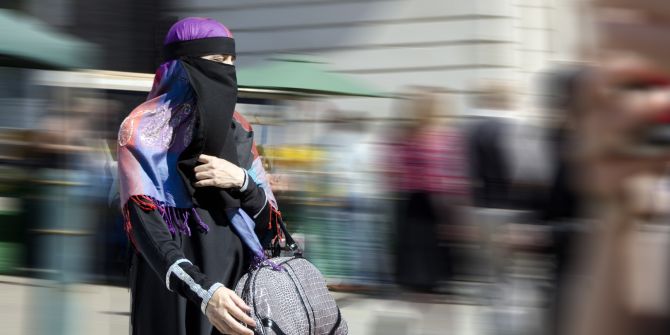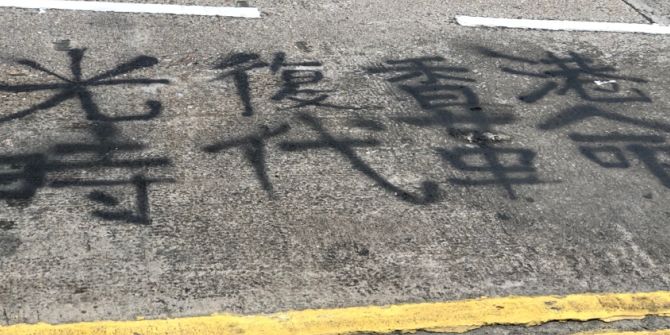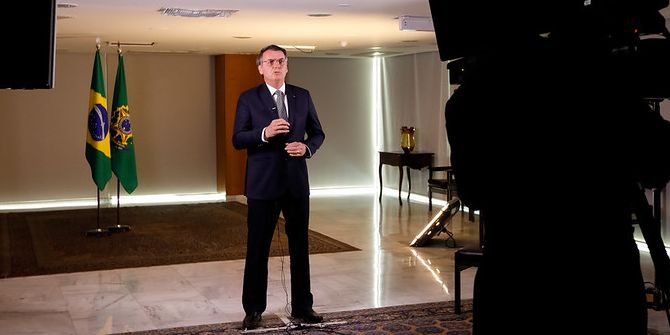Following Boris Johnson’s controversial comments last month, the debate surrounding the niqab and its compatibility with ‘British values’ has been reignited. Anna Piela notes how the voices of niqab-wearers are often side-lined in this debate. The women highlight the continued prevalence of a fixed notion of Britishness which makes little room for many British Muslims’ rejection of an ‘either/or’ approach to identity.

The latest niqab controversy, fuelled in August 2018 by Boris Johnson, prompted me to take stock of the niqab narratives present in the media since 2006. The manner in which Jack Straw’s views on women coming to his MP surgery wearing the niqab were conveyed seems understated, benign even: ‘I felt uneasy talking to someone I couldn’t see’; ‘the conversation would be of greater value if the lady took the covering from her face’, he wrote in his column in the Lancashire Telegraph in 2006.
Twelve years later, the fact that some Muslim women choose to cover up their faces in public is still dragged up again and again by politicians who don’t pull their rhetorical punches any more in their race to the political gutter. Compare Jack Straw’s tentative criticism with Boris Johnson’s column in the Daily Telegraph where he wrote that he felt ‘fully entitled’ to see his constituents’ faces, and that women who covered their faces looked like ‘letterboxes’ and ‘bank robbers’. The civility of the niqab debate has clearly come down a notch or two in the last decade.
Popular interest in the lives of niqab-wearers usually erupts shortly after such unsavoury words are uttered and public figures on both ends of the political spectrum have had a chance to restate their position on the niqab for the umpteenth time. Increasingly, women who wear the niqab are given a platform from which to defend themselves at times like this. Yet their views are welcome as long as they are ‘in response’ to whatever controversial or offensive opinion a politician thought appropriate to share with general public. They’re rarely welcome to come to the media with their own agenda.
Difference in style aside, Straw and Johnson’s statements revealed a similar sentiment: their preference is to see their interlocutor’s face. However, in order to validate this personal preference, they both referred to the seemingly objective construct of ‘British culture’ where, apparently, the full view of each other’s face is the sine qua non for communication. Forget telephone calls, texts, email, podcasts, or the good old wireless. The face of the stubborn Muslim woman must be revealed to the (male) gaze. It is, curiously, almost always a man who starts a niqab row.
Straw was honest, at least, when he wrote that ‘so many of the judgments we all make about other people come from seeing their faces’. So it’s about his freedom to make judgments, as much as the ease of communication. It’s unclear what judgments Jack Straw intended to make. Was it about how pretty the woman was? What shade of skin she had? Or did he genuinely think that somehow the view of her mouth would ensure that he was able to pick up on any dishonesty?
Jack Straw’s discomfort was palpable in his comment, in the same article, that what really got him thinking was a conversation with a niqab-wearing woman and her husband, both of whom spoke with an impeccable English accent and had graduated from British universities. In his mind, there was an incongruity between the facts that a woman who could speak perfect English and was educated also wore a niqab. In other words, she had an excellent chance to ‘pass’ for a good, assimilated immigrant and she turned it down. She could play the game in which immigrants are almost always on the losing side but playing as good sports, but she wasn’t. This brief reference to that exchange encapsulates one category of reactions to the niqab that could be labelled DISAPPOINTED and INDIGNANT. You could have embraced my ‘culture’ but deemed it undesirable after all! How come?
In 2013, when another niqab row flared up, I really wanted to go beyond the tired tropes of what others think about the niqab to try to understand the lives and perspectives of the women who wear it. I was browsing the web in search of any piece, journalistic or academic, that would throw some light on the lives of these women, the reluctant heroines of the niqab narratives (‘victims’, ‘terrorists’, or stubborn refuseniks of the opportunities that the West evidently affords women). There were perhaps three or four articles, all of them in local press, where niqab-wearing women were given a chance to talk. This was astounding, given the hundreds of columns in which journalists opined on the niqab without bothering to talk to a woman who wears one. It cannot be that difficult to find one in a larger city. In my experience (and I have talked to over 30 niqab-wearers), they are eager to be heard.
One of the niqab-wearing women I interviewed, a Scot and an anthropologist who had converted to Islam, commented on essentialised Britishness that calls for affording further privilege to those in power:
It’s very what we call, in anthropology, ‘ethnocentric’. And it’s very colonial Britishness. This is the norm, everything else is deviant, negative or positive. Taking that Britishness or colonial white Anglo-Saxon male view of life as the norm, anything outwith is deviant.
She correctly identified deviancy attached to the niqab, as well as the source of that identification – white, Anglo-Saxon powerful men who hark back to the Empire era as the ‘golden time’ for the British. She further pondered on the impact such ideas have on minority ethnic lives:
When you’re trying to, like, assimilate us, make us become what you view as British (emphasis mine – AP), that is where the issue comes up, and that’s where we all legitimately stand up and say ‘I’m different from you, and I want to be different from you’. Not that I don’t want to be British, it’s just I have my own way of living my life.
The British identity that she proposes here is diverse and flexible, based on the recognition that Britishness encompasses various lifestyles and systems of values. Despite internal identity differences (for example between the South and North of England) the white English population is not so keen to accept this idea of diversity as enriching. According to a 2016 YouGov poll, 57 per cent of Britons would support a ‘burka ban’.
This number includes some Muslims, too. Many women I spoke with told me that their middle-class Muslim families resented their daughters adopting the face veil. It was explained to me that after struggling with racism in the 60s, 70s and 80s, they gained a better socioeconomic status thanks to education, and could not understand why the women would willingly expose themselves to Islamophobia, the ‘new racism’. The families feared their hard-earned position in society would be damaged by association with female relatives adopting a religious practice perceived as backward and fundamentalist. One British Pakistani woman told me of a serious conflict in the family when they realised that she had adopted the niqab:
All of my family are, are… dentists, doctors, you know, they’re British (…) they disowned me when I put it on, and, even today I can’t go there [the family home] with my niqab on. (…) I need my children to go and see my mum and now my mum is old, you know, and I don’t want to upset her so I leave my niqab when I go there.
In her story, she connected the fact that her relatives were educated to the aspiration to become British, which is exactly what Jack Straw bemoaned about his constituent refusing to do in 2006. Another British Pakistani woman told me that her relatives seemed uncomfortable being seen with her in public, which impacts her relationships with them:
I went out with my sisters. And my sister said to me, are you going to do the ninja? And I said, no, I’ll remove it now, because they’ve been out with me before and I’ve had it on, no, I’ll remove it. I said I will have my two-piece hijab on but I won’t wear the niqab.
The ‘ninja’ epithet was particularly hurtful as it is a common Islamophobic slur that is hurled at niqab wearers in the streets (see Chakraborti and Zempi, 2014). Just as the other family disciplined my interviewee, distancing oneself from the niqab on the part of the sister likely constituted performing the ‘traditional’ Britishness, as did other activities which this woman described in the context of her family:
I just have this feeling that [in the UK] ‘you can be Muslim if you want to be but you gotta blend with us’, which they are. I mean just observing my own family they, you know, they’ve got pianos in their house they go for music lessons and, you know, they do nativity plays. My nieces are dressed up like Mary and Jesus and everything and they’re showing me and I am like, ‘Oh! Mmmm!’ because you know everyone has a right to live their life how they want to.
Such narratives reveal a split in Muslim, mostly British Pakistani, communities in the UK where the first generation of migrants collectively worked hard to accumulate cultural, social and economic capital, and often faced racism. Some members of the subsequent generations reject these capitals and reframe their lives according to variously conceived Islamic rules, rejecting what they see as British and Pakistani ‘cultural sediment’. The reason why all the women I interviewed wore the niqab was not just the adoption of a ‘different lifestyle’ for its own sake, nor was it a ‘cultural thing’ as is often suggested. They all talked about a strong relationship with God, and the desire to guard their modesty and emulate the wives of the Prophet who covered their faces.
These motivations are often dismissed by those who claim a degree of authority in Islam: scholars, academics, even lay Muslims and non-Muslims (as Jack Straw did in his 2006 article). The criticism is that the Qur’an does not mention the niqab, which therefore is not required in Islam. This argument is tainted by Western understandings of what religious practice is and isn’t: contrary to popular conviction, it is not just doctrine (textual sources such as Scripture) that defines religious practices, but also their popular interpretations which have evolved over time. One example of such practice is the hijab, often accepted universally as a ‘symbol of Islam’, even though, like the niqab, it is absent from Islamic doctrine which only mentions covering one’s ‘adornments’. The interpretation is left to the believer what these adornments are. Many Muslim women interpret this as covering their cleavage but not their heads, while others take it to mean the hair; some, like my interviewees, interpret this as hair and the face, or a part thereof. It is all a part of the interpretive diversity of Islam.
About the author
 Anna Piela has a PhD in Women’s Studies from the University of York. She has worked as a lecturer in Religious Studies, and is now a visiting scholar in Women’s, Gender, and Sexuality Studies at Northeastern University in Boston, USA. The complete findings of the niqab project will be published by Bloomsbury as her second book, Wearing the Niqab: Fashioning Identity Among Muslim women in the UK and the US. She has also written shorter pieces (in the Public Spirit and New Statesman) addressing British disputes over the niqab. Her blog is at https://annamagdalenapiela.wordpress.com/ and she tweets at @annapiela999.
Anna Piela has a PhD in Women’s Studies from the University of York. She has worked as a lecturer in Religious Studies, and is now a visiting scholar in Women’s, Gender, and Sexuality Studies at Northeastern University in Boston, USA. The complete findings of the niqab project will be published by Bloomsbury as her second book, Wearing the Niqab: Fashioning Identity Among Muslim women in the UK and the US. She has also written shorter pieces (in the Public Spirit and New Statesman) addressing British disputes over the niqab. Her blog is at https://annamagdalenapiela.wordpress.com/ and she tweets at @annapiela999.
Note: This piece gives the views of the author, and not the position of the LSE Religion and Global Society blog, nor of the London School of Economics.






The author is a feminist and therefore the views. The author is perhaps unaware that it this interpretive diversity of Islam that seems to be at the heart of Islamic discourse and there is a problem with Islamic discourse. This very interpretive diversity is the cause of fundamentalism and terrorism. Diversity must be qualified, interpretations must be qualified. Some interpretations are clearly wrong and cause problems for the religion. Niqab is not part of the religion and doesn’t make it correct to wear it just because one has interpreted the religious text in a certain way. It is of no consequence whether one wears niqab or not. It does seem to be a problem however in the west when one wears it and even in some Muslim countries where the secular force is able to dictate. If it is a problem then talk about the right doctrines not incorrect doctrines. If it does not matter whether one wears the niqab or not then the interpretations can be many because there is no consequence. If there is consequence then one must try to determine the truth. Falsehood or a mixture of falsehood and some truth will cause utter chaos. This is what we have in Islamic discourse.